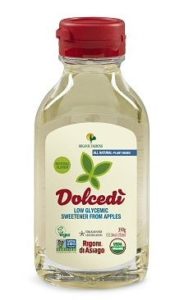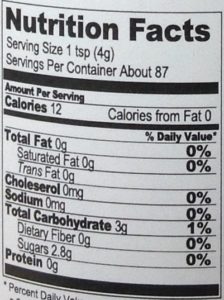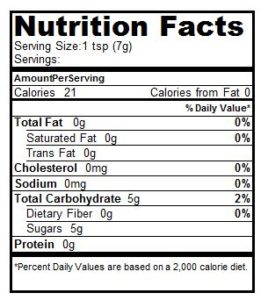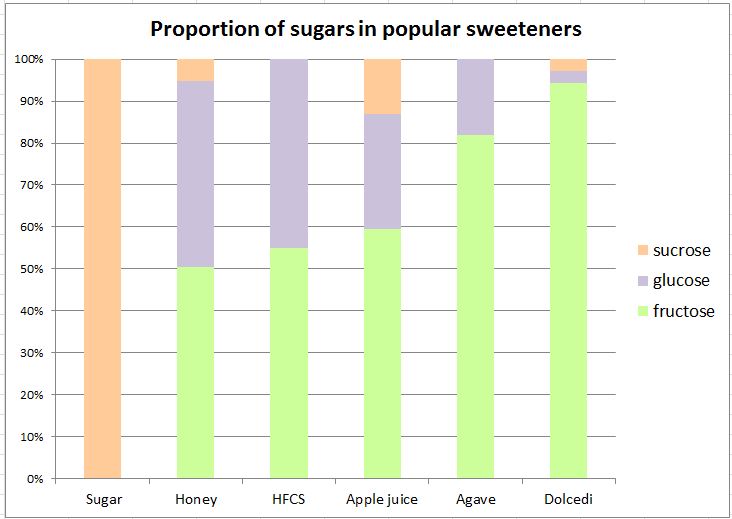 I recently received a sample for review of a new sweetener from Italy called Dolcedi, made from organic apples. According to the manufacturer’s website:
I recently received a sample for review of a new sweetener from Italy called Dolcedi, made from organic apples. According to the manufacturer’s website:
“Dolcedì’ can be used any way you would use traditional table sugar or honey and in the same proportions; one teaspoon of sugar equals one teaspoon of Dolcedì’.”
It’s promoted as having a lower glycemic index than sugar–which it does. But the manufacturer also claims that it’s 25% lower in calories than sugar–which it is not.
When used as directed, Dolcedi actually provides 31% MORE calories than sugar.
How Did This Happen?!
The mislabeling appears to be an innocent–although extremely careless–error. As you can see, the label says that 1 teaspoon (4g) of Dolcedi provides 12 calories.

But something didn’t seem right to me. And when I got out my digital scale, I discovered that 1 teaspoon of Dolcedi does not weigh 4 grams. It actually weighs 7 grams, which suggests that it contains 21 calories per teaspoon, or 75% more than what the label says.
When I contacted the company (through their US based public relations firm), they confirmed that the label is incorrect. Here’s their explanation:
“The fact that Rigoni di Asiago is a European brand and Europe’s measuring practices are all metric system seems to be at the root of this miscommunication. When their team determined the caloric differences between regular sugar and Dolcedì, they were comparing these ingredients in grams. (Understandable since this is the standard unit of measuring ingredients for them!) By weight, Dolcedì does in fact have 25% fewer calories than sugar.”
While I get that Europeans may not be accustomed to English units, it’s a little hard to excuse the confusion over units of weight and volume. The metric system does include both. ((And for their reference, 1 teaspoon = 5 milliliters). The company’s rep says that they will be changing their labeling and marketing materials to correct this error and to revise their usage instructions. (They’re now saying that Dolcedi shouldn’t be used teaspoon for teaspoon.)
Obviously, it will take a while to get correctly labeled products on store shelves in the US. However, it has now been a couple of weeks since I brought the problem to their attention and no changes have been made on their website.
Update: 5/09/16: It has now been six weeks since I alerted the company about the error and they have yet to update their website with corrected calorie and usage information.
If you’re using this product, here’s my best guess at what the corrected label should look like:
What Makes Dolcedi Low Glycemic
With all of that going on, it’s easy to overlook their other big claim, which appears to be entirely accurate: Dolcedi sweetener has a glycemic index of just 22 (compared to sugar, which has a glycemic index of 100), meaning that it should cause much less of a rise in your blood sugar.
The reason that Dolcedi has such a low glycemic index is that it is almost 100% fructose. Apples contain a mix of fructose (which is processed in the liver and does not raise blood sugar), glucose, and sucrose (both of which are absorbed into the blood stream). According to company sources, Dolcedi is made by taking the juice from organic apples and filtering it to remove almost all of the glucose and sucrose.
Ironically, some of the people that will be most excited about this “all-natural” low-glycemic sweetener are the same people who have been so freaked out over high fructose corn syrup. If, despite all my efforts to clear up misunderstandings about fructose, you still believe fructose is something you need to avoid, then you’re going to want to steer clear of Dolcedi.
If you’re looking for a sweetener that’s less likely to raise your blood sugar, on the other hand, Dolcedi may be for you. Just be sure to use it with the same degree of moderation that you’d use for any other added sweetener. The goal is to limit added sugars from all sources to no more than 25 grams a day. If Dolcedi if your sweetener of choice, that would be about 5 teaspoons (equaling 104 calories).
How to Use: Because fructose is about 75% sweeter than sucrose (table sugar), I would suggest replacing 1 teaspoon of sugar with 1/2 teaspoon of Dolcedi to get the same degree of sweetness. When used this way (as opposed to substituting teaspoon for teaspoon), you’d cut calories from sugar by about one third.



I suspect you’re right to now question the innocence of their mislabeling. Manufacturers have little incentive to correct these self-serving “errors”. I had a similar experience about a decade ago. A few products at my beloved Trader Joe’s listed sodium content on their nutrition facts that was blatantly low. The mislabeling was so obviously, I assumed it had to be an honest mistake or even a typo, and that a simple phone call would fix the problem.
But after a year of getting the runaround, and ultimately being told their numbers were correct, my quixotic mission began in earnest. Out of frustration, and at my own expense, I ended up sending a sample to private lab that confirmed the obvious- that their figure was egregiously low (by nearly an order of magnitude). Ultimately, all the labels were revised, but only after the CSPI offered to get involved.
The FDA seems overwhelmed and underfunded in just about everything they do. So in the absence of any real carrots or sticks, it’s up to us consumers and groups like CSPI (or perhaps lawyers) to be the watchdogs in this arena.
1. I want a low-carb sweetener to replace Splenda and have ordered Swerve.
2. I read about their mislabeling on at least one other site.
3. I bought a bottle at Whole Foods today that STILL lists the serving size as 1 tbsp., when the company said it should be 1 tsp.
You are excellent for paying close attention, when most of us don’t. I am angered by their mislabeling and think there’s no good excuse for it, so I can’t trust them and will return the product.
I recently purchased Dolcedi (Dec 2016) and the label reads as follows:
serving size: 1/2 Tsp (4g)
Calories per serving: 12
Sugars: 2.8g
3/25/17 – in Whole Foods, seeing product for the first time. Label still says 12 calories, 2.8g sugars, 3g carbs. Also, it says the product is only 67% fructose, although given its composition, I don’t see how that’s possible.
I just got some at Whole Foods, where they are apparently discontinuing it, and it says something completely different and even more preposterous:
Serving Size 1 TBSP (Xml)
(what is X ml?!)
Calories 15
(and then skipping down)
Total Carbohydrate 3.8g
Sugars 3.6g
So they are now saying the serving size is a whole TABLESPOON, but that it has even fewer calories in a TBSP than it had in a teaspoon… Hmm… I’m not about to blame anyone, as America really should have switched to the more logical metric system when most of the rest of the world did, but I wish they would clear this up, and I’m guessing that it may be the reason that Whole Foods is discontinuing it!
The label is now correct. Serving size: 1/2 tsp (4g) and calories per serving: 12 calories.
It’s really about if you have health issues and cannot use sugar and anything that will spike your glucose levels. If your a diabetic or have fatty liver disease WHAT IS THE BEST sweetener TO USE? I bake with this Dolcedi, I use it instead of high fructose corn syrup which came out my my diet over 20 years ago.
They say so many things that you believe this is our health that they are talking about. What sweetener can a diabetic, cancer patient or a person with a fatty liver use? Stevia ?
Stevia and sugar alcohols (Truvia, Purevia) will have minimal effect on blood sugar but you might not get great results with them in baking.
Dolcedi may be a better choice than regular sugar or corn syrup in terms of blood sugar. But you’d still want to consume it (and foods sweetened with it) in small quantities.
I bought a bottle yesterday, April 9, 2019. Best by date was Sept. 2021.
As it was a new product to me I set about doing a bit of research on it and found your page here.
I thought it might help your readers to know they have indeed changed he labelling.
They’ve changed the serving size on the label to 1/2 teaspoon, calories 12, total carbs 3g, total sugars,3g.
Once again, take note everyone, that these numbers are now based on a HALF TEASPOON serving size, so the numbers for this product are now recorded on the label as being even higher than the last estimated totals from this page.
Just bought this September 2021
Label says “ 1/2 teaspoon (4g/0.14 oz)
Calories 10
Total sugars 3g
Glycemic index 22.5
Fructose 64.6g
Glucose 3.6g
Sucrose 1.6g
Sorbitol 1.87g
I question the process by which this manufactured. I have taken fresh organic apples, juiced them, filtered them and then reduced them to a syrup, but even with having added lemon juice to prevent oxidation the syrup is brown. This product seems to me very denatured and far removed from an apple.
How did they get this thick clear syrup????